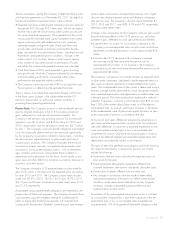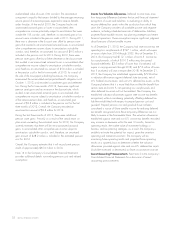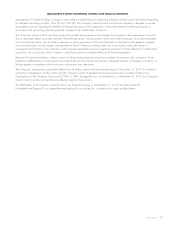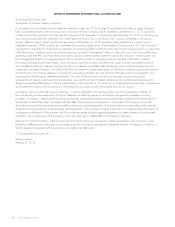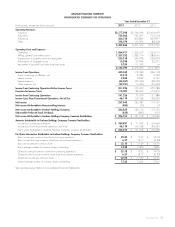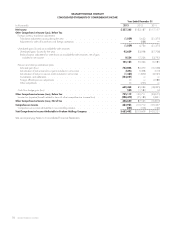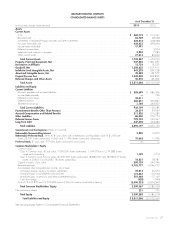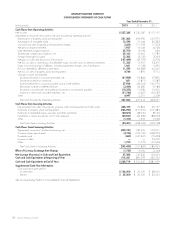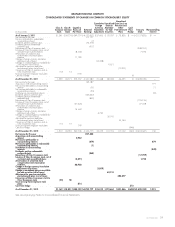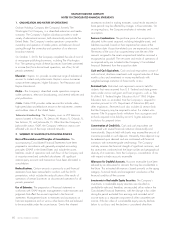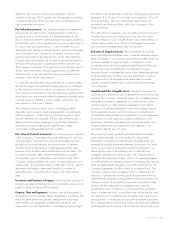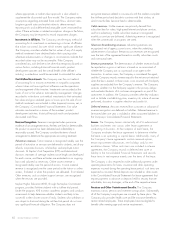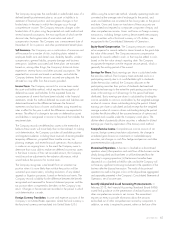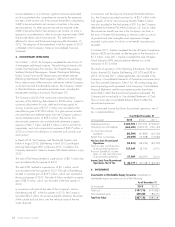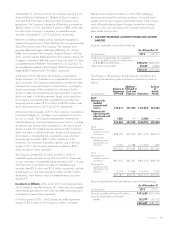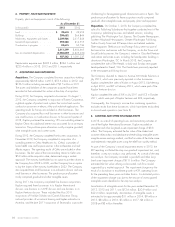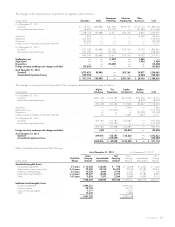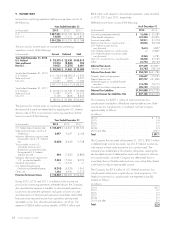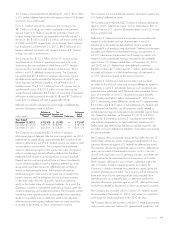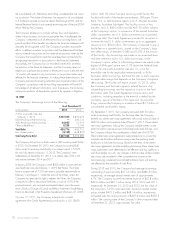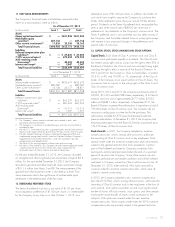Washington Post 2013 Annual Report Download - page 79
Download and view the complete annual report
Please find page 79 of the 2013 Washington Post annual report below. You can navigate through the pages in the report by either clicking on the pages listed below, or by using the keyword search tool below to find specific information within the annual report.temporary, the Company will record a write-down, which is
included in earnings. The Company uses the average cost method
to determine the basis of the securities sold or reclassified out of
other comprehensive income.
Fair Value Measurements. Fair value measurements are determined
based on the assumptions that a market participant would use in
pricing an asset or liability based on a three-tiered hierarchy that
draws a distinction between market participant assumptions based on
(i) observable inputs, such as quoted prices in active markets (Level 1);
(ii) inputs other than quoted prices in active markets that are
observable either directly or indirectly (Level 2); and (iii) unobservable
inputs that require the Company to use present value and other
valuation techniques in the determination of fair value (Level 3).
Financial assets and liabilities are classified in their entirety based on
the lowest level of input that is significant to the fair value measure.
The Company’s assessment of the significance of a particular input to
the fair value measurements requires judgment and may affect the
valuation of the assets and liabilities being measured and their
placement within the fair value hierarchy.
For assets that are measured using quoted prices in active markets,
the total fair value is the published market price per unit multiplied
by the number of units held, without consideration of transaction
costs. Assets and liabilities that are measured using significant other
observable inputs are primarily valued by reference to quoted prices
of similar assets or liabilities in active markets, adjusted for any
terms specific to that asset or liability.
The Company measures certain assets—including goodwill;
intangible assets; property, plant and equipment; cost and equity-
method investments—at fair value on a nonrecurring basis when
they are deemed to be impaired. The fair value of these assets is
determined with valuation techniques using the best information
available and may include quoted market prices, market
comparables and discounted cash flow models.
Fair Value of Financial Instruments. The carrying amounts reported
in the Company’s Consolidated Financial Statements for cash and
cash equivalents, restricted cash, accounts receivable, accounts
payable and accrued liabilities, the current portion of deferred
revenue and the current portion of debt approximate fair value
because of the short-term nature of these financial instruments. The
fair value of long-term debt is determined based on a number
of observable inputs, including the current market activity of the
Company’s publicly traded notes, trends in investor demands and
market values of comparable publicly traded debt. The fair value of
the interest rate hedge is determined based on a number of
observable inputs, including time to maturity and market interest
rates.
Inventories and Contracts in Progress. Inventories and contracts in
progress are stated at the lower of cost or realizable values and are
based on the first-in, first-out (FIFO) method.
Property, Plant and Equipment. Property, plant and equipment is
recorded at cost and includes interest capitalized in connection with
major long-term construction projects. Replacements and major
improvements are capitalized; maintenance and repairs are
expensed as incurred. Depreciation is calculated using the straight-
line method over the estimated useful lives of the property, plant and
equipment: 3 to 20 years for machinery and equipment; 20 to 50
years for buildings. The costs of leasehold improvements are
amortized over the lesser of their useful lives or the terms of the
respective leases.
The cable division capitalizes costs associated with the construction
of cable transmission and distribution facilities and new cable
service installations. Costs include all direct labor and materials, as
well as certain indirect costs. The cost of subsequent disconnects
and reconnects are expensed as they are incurred.
Evaluation of Long-Lived Assets. The recoverability of long-lived
assets and finite-lived intangible assets is assessed whenever adverse
events or changes in circumstances indicate that recorded values may
not be recoverable. A long-lived asset is considered to not be
recoverable when the undiscounted estimated future cash flows are
less than the asset’s recorded value. An impairment charge is
measured based on estimated fair market value, determined primarily
using estimated future cash flows on a discounted basis. Losses on
long-lived assets to be disposed of are determined in a similar
manner, but the fair market value would be reduced for estimated
costs to dispose.
Goodwill and Other Intangible Assets. Goodwill is the excess of
purchase price over the fair value of identified net assets of businesses
acquired. The Company’s intangible assets with an indefinite life are
principally from franchise agreements at its cable division, as the
Company expects its cable franchise agreements to provide the
Company with substantial benefit for a period that extends beyond
the foreseeable horizon, and the Company’s cable division
historically has obtained renewals and extensions of such agreements
for nominal costs and without any material modifications to the
agreements. Amortized intangible assets are primarily student and
customer relationships and trade names and trademarks, with
amortization periods up to 10 years.
The Company reviews goodwill and indefinite-lived intangible
assets at least annually, as of November 30, for possible
impairment. Goodwill and indefinite-lived intangible assets are
reviewed for possible impairment between annual tests if an event
occurs or circumstances change that would more likely than not
reduce the fair value of the reporting unit or indefinite-lived
intangible asset below its carrying value. The Company tests its
goodwill at the reporting unit level, which is an operating segment
or one level below an operating segment. In reviewing the carrying
value of indefinite-lived intangible assets at the cable division, the
Company aggregates its cable systems on a regional basis. The
Company initially assesses qualitative factors to determine if it is
necessary to perform the two-step goodwill impairment review or
indefinite-lived intangible asset quantitative impairment review. The
Company reviews the goodwill for impairment using the two-step
process and the indefinite-lived intangible assets using the
quantitative process if, based on its assessment of the qualitative
factors, it determines that it is more likely than not that the fair value
of a reporting unit or indefinite-lived intangible asset is less than its
carrying value, or if it decides to bypass the qualitative assessment.
The Company reviews the carrying value of goodwill and indefinite-
lived intangible assets utilizing a discounted cash flow model, and,
2013 FORM 10-K 61


